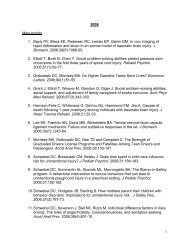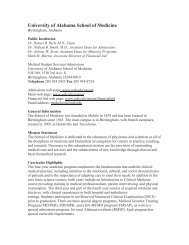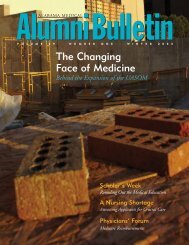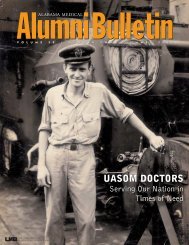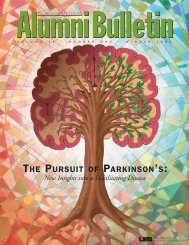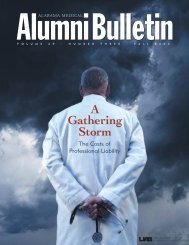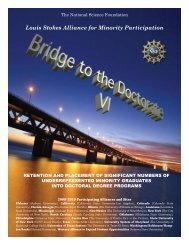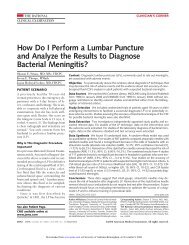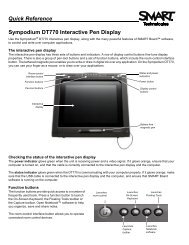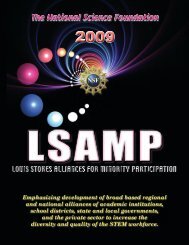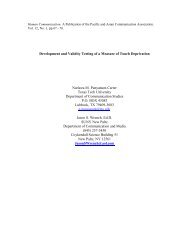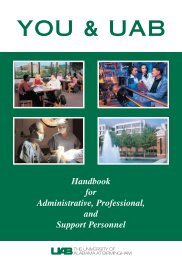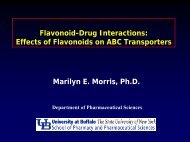AnnuAl RepoRt - University of Alabama at Birmingham
AnnuAl RepoRt - University of Alabama at Birmingham
AnnuAl RepoRt - University of Alabama at Birmingham
You also want an ePaper? Increase the reach of your titles
YUMPU automatically turns print PDFs into web optimized ePapers that Google loves.
50<br />
New Research Labor<strong>at</strong>ory<br />
Targeting Distracted Driving<br />
Established by UAB UTC<br />
When UAB UTC Leadership selected Dr. Despina<br />
(Dessie) Stavrinos to become the UTC’s first Post-<br />
Doctoral Fellow in the Spring <strong>of</strong> 2009 and Dr. Russ Fine<br />
agreed to be her mentor, leadership already knew Dessie<br />
was an energetic, intellectually honest young investig<strong>at</strong>or.<br />
They also knew she would use the multiple skill-sets she<br />
acquired and honed during her post-gradu<strong>at</strong>e fellowship<br />
<strong>at</strong> the UAB UTC to become a highly successful transport<strong>at</strong>ion<br />
research scientist and educ<strong>at</strong>or. Wh<strong>at</strong> they didn’t<br />
know was how quickly Dr. Stavrinos would make the<br />
most <strong>of</strong> the opportunities provided through her affili<strong>at</strong>ion<br />
with the UAB UTC.<br />
As part <strong>of</strong> her prepar<strong>at</strong>ion for post-doctoral training, Dr.<br />
Stavrinos conceptualized and designed a research project<br />
th<strong>at</strong> had been approved by UAB UTC Leadership and selected<br />
for funding by the UAB UTC Advisory Board. Her<br />
position provided a salary consistent with UAB guidelines<br />
for post-doctoral students, <strong>of</strong>fice space and the opportunity<br />
to conduct her research project. Many people would<br />
have been happy to stop right here – not Dr. Stavrinos.<br />
Before her first <strong>of</strong>ficial day as the UTC’s post-doctoral<br />
trainee, Dr. Stavrinos expanded her original, UAB UTC<br />
sponsored research award and acquired supplemental<br />
funding by securing a modest grant award from Children’s<br />
Hospital <strong>of</strong> Philadelphia (CHOP). The CHOP award<br />
enabled her to add a component to her existing UAB UTC<br />
research project, something th<strong>at</strong> would not have been possible<br />
without the initial UAB UTC award. Dr. Stavrinos<br />
now had two sources <strong>of</strong> funding, an expanded research<br />
project, a salary and an <strong>of</strong>fice. Once again, many people<br />
would have been happy to stop there, but not Dr. Stavrinos.<br />
Soon after beginning her Post-Doctoral training on June 1,<br />
2009, Dr. Stavrinos established the Transl<strong>at</strong>ional Research<br />
for Injury Prevention (TRIP) Labor<strong>at</strong>ory ® <strong>at</strong> the UAB<br />
UTC (www.triplabor<strong>at</strong>ory.com). The TRIP ® Lab’s mission<br />
is to provide a scientific environment th<strong>at</strong> promotes the<br />
gener<strong>at</strong>ion <strong>of</strong> knowledge intended to increase our understanding<br />
<strong>of</strong> the behavioral aspects <strong>of</strong> distracted driving<br />
among teens and young adults and then transl<strong>at</strong>e those<br />
findings into injury prevention and control practice. Since<br />
its establishment less than a year ago, well over a dozen<br />
gradu<strong>at</strong>e and undergradu<strong>at</strong>e students have been a part <strong>of</strong><br />
the TRIP Labor<strong>at</strong>ory research group. Working in the TRIP<br />
Lab <strong>of</strong>fers a unique opportunity for students to learn about<br />
research and something about how non-traditional<br />
disciplines can actually have important roles in the<br />
uab utc annual report 2009-2010<br />
“As a psychologist by<br />
training, it’s deeply<br />
rewarding to see<br />
traditional transport<strong>at</strong>ion<br />
disciplines demonstr<strong>at</strong>e a<br />
keen appreci<strong>at</strong>ion for behavioral research’s role<br />
solving critical transport<strong>at</strong>ion issues.”<br />
Dr. Despina (Dessie) Stavrinos<br />
transport<strong>at</strong>ion field. Some students are earning course<br />
credit for their work in the TRIP Lab. (See Winter 2009<br />
UAB UTC UPDATE for more details www.uab.edu/utc.)<br />
Work being conducted in the TRIP Lab is not going<br />
unnoticed. Within the past year, Dr. Stavrinos has been<br />
fe<strong>at</strong>ured numerous times in print, electronic and television<br />
media, both n<strong>at</strong>ionally and intern<strong>at</strong>ionally, explaining and<br />
discussing the impact <strong>of</strong> distracted driving. She served as<br />
the Research Panel moder<strong>at</strong>or <strong>at</strong> the <strong>Alabama</strong> Distracted<br />
Driving Summit and, along with UAB UTC Director Dr.<br />
Russ Fine, was one <strong>of</strong> only two individuals from the St<strong>at</strong>e<br />
<strong>of</strong> <strong>Alabama</strong> invited to <strong>at</strong>tend and particip<strong>at</strong>e in the US-<br />
DOT Secretary’s first N<strong>at</strong>ional Distracted Driving Summit<br />
in Washington, DC in l<strong>at</strong>e 2009.<br />
So, in the year since beginning her Post-Doctoral Fellowship<br />
with the UAB UTC, Dr. Despina Stavrinos has<br />
secured outside funding to supplement her research, established<br />
the novel, highly successful TRIP Labor<strong>at</strong>ory, been<br />
fe<strong>at</strong>ured n<strong>at</strong>ionally and intern<strong>at</strong>ionally as a distracted driving<br />
expert, and is mentor to over a dozen students. Once<br />
again, most people would have been content to stop right<br />
here – but, you guessed it – not Dr. Stavrinos.<br />
In February 2010, Dr. Stavrinos obtained funding from the<br />
<strong>University</strong> Transport<strong>at</strong>ion Center for <strong>Alabama</strong> (UTCA) to<br />
further expand her distracted driving research. This new<br />
project, Impact <strong>of</strong> Distracted Driving on Traffic Congestion,<br />
examines driver behavior in a virtual driving simul<strong>at</strong>or<br />
in different levels <strong>of</strong> traffic flow while engaging in<br />
various distracting activities. It also examines the factors<br />
th<strong>at</strong> predict risky driving behavior in the varying traffic<br />
and distraction conditions. Dr. Stavrinos and the TRIP<br />
Lab group are in the process <strong>of</strong> recruiting participants for<br />
this study.<br />
As she is quick to point out, “Without the research experience<br />
and the resources made possible by the support <strong>of</strong><br />
the UAB UTC, I would not have been able to achieve as<br />
much as I have in such a short period <strong>of</strong> time.”<br />
Nearly 6,000 people died in 2008<br />
in crashes involving a distracted<br />
driver, and more than half a<br />
million were injured. (NHTSA)



